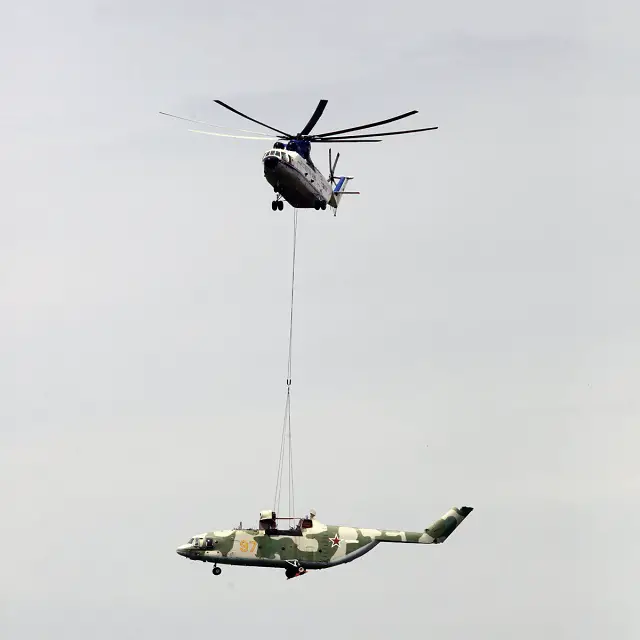| a | |||
| |
|||
Defense Industry News - Russia |
|||
Mi-26T
completes unique transport mission by lifting 14-tonne fuselage of a Mi-26
military helicopter |
|||
The
world's heaviest-lifting commercial helicopter, the Mi-26T, produced by
Russian Helicopters (part of State Corporation Rostec) has successfully
completed a mission to transport the 14-tonne fuselage of a Mi-26 military
transport helicopter from Yoshkar-Ola to Rostov-on-Don. The Mi-26(T) helicopter
is the only model able to fly while carrying cargo this size and weight.
The fuselage was transported by Rostvertol-Avia for repair work as ordered
by Experimental Design Bureau Rostov-Mil. |
|||
 The world's heaviest-lifting commercial helicopter, the Mi-26T, has successfully completed a mission to transport the 14-tonne fuselage of a Mi-26 military transport helicopter from Yoshkar-Ola to Rostov-on-Don. Picture: Russian Helicopters |
|||
"The
operation to transport the fuselage took nine days," Rostvertol-Avia
Airlines' crew commander Valery Chumakov said. "The route passed
through Cheboksary, Ulyanovsk, Saransk, Penza, Saratov, Kamyshin, Volgograd,
and Volgodonsk. There were various weather conditions along the route
- from winter to summer - but that did not cause any difficulties. I have
been working on Mi-26Ts for over 15 years and can say with confidence
that this helicopter is ideally suited to operations like this." Similar operations, to transport several helicopter fuselages to Rostvertol locations for further repair work, were carried out in 2009. Thanks to these and other operations the Mi-26T has proved to be the most effective, and in some cases the only possible, way to transport large cargo boasting complex dimensions internally in its internal cabin or on its external sling from a range of remote locations. Mi-26 helicopters are also used to transport paratroopers, the sick and injured, to deliver fuel and extinguish fires. Preparatory work is currently underway at Rostvertol for the series production of the upgraded Mi-26T - the Mi-26T2 helicopter with reduced crew and the latest avionics. These modernisations significantly increase flight safety, improve its ergonomics, and facilitate the work of the helicopter crew. The Mi-26T was designed based on the military transport Mi-26 helicopter. Work to design the initial model by Mil Moscow Helicopter Plant (now part of Russian Helicopters) started in the 1970s and it was first unveiled to the global public at the Paris airshow in 1981, after the USSR Defence Ministry recommended serial production be launched. It enjoyed such international success that the decision was taken to develop a commercial model, the Mi-26T. Serial production was launched on that in 1985. Unlike its predecessor, the helicopter was fitted with additional radio communications, avionics, and navigation systems, and an automatic hover system. It was also stripped of its military counterpart's arms and armour. This new commercial model quickly found a broad range of commercial uses, and a number of different configurations of it started to appear on the market. In 1996, flight tests began on the re-fuelling variant of the Mi-26T, and in 1997 the fire-fighting model took to the skies. Thanks to the Mi-26T's outstanding characteristics, it has been used in a number of unique missions. In Krasnoyarsk Territory in 1999 it was used to carry a mammoth encased in a block of ice. In 2001, the Mi-26T helped restore the cupola and cross to the church in Pavlovskaya settlement, Krasnodar. In 2002 and 2009 it helped evacuate 11-tonne fuselages from US Boeing CH-47 Chinook helicopters that had crashed in Afghanistan. In 2009, the Mi-26T transported a 27-metre Alinghi 5 catamaran, and a Tu-134 passenger plane. No helicopter in the history of the helicopter-building industry has ever carried out operations of this scale. This year marks 30 years since serial production was launched on the Mi-26T. This anniversary of the production of these helicopters, which can lift up to 20-tonnes of cargo, was marked by Rostvertol (part of Russian Helicopters), which produces this model. Rostvertol, a Russian Helicopters company, produces a wide range of Mi- helicopters and carries out repair and modernisation work on helicopters, supplies aviation engineering materials and provides related services. Currently Rostvertol is involved in the series production of new generation military helicopter Mi-28N Night Hunter (Mi-28NE export variant); the Mi-35M combat support helicopter; and the world's heaviest multirole transport helicopter - the Mi-26T. |
|||
Mi-26T completes unique transport mission by lifting 14-tonne fuselage of a Mi-26 military helicopter
- Posted On
















